Praemium Financial Statement Income Tax Analysis Assignment
VerifiedAdded on 2023/04/20
|12
|2970
|426
Homework Assignment
AI Summary
This assignment analyzes Praemium's income tax accounting based on its 2018 annual report. It examines the cash paid for income tax over two years, identifying the amounts and their locations within the financial statements. The analysis includes a comparison of income tax expenses, the reconciliation of tax expense with profit before tax, and a discussion of deferred tax assets and liabilities. The assignment explores the items that create these deferred taxes, distinguishing between assets and liabilities and assessing the closing balances. Furthermore, it compares and contrasts Praemium's income tax items with industry competitors, evaluating the effective income tax rate and potential tax benefits. The analysis also covers depreciation, intangible assets, shareholder equity, and changes in accounting policies, highlighting their relevance to the company's income tax position.
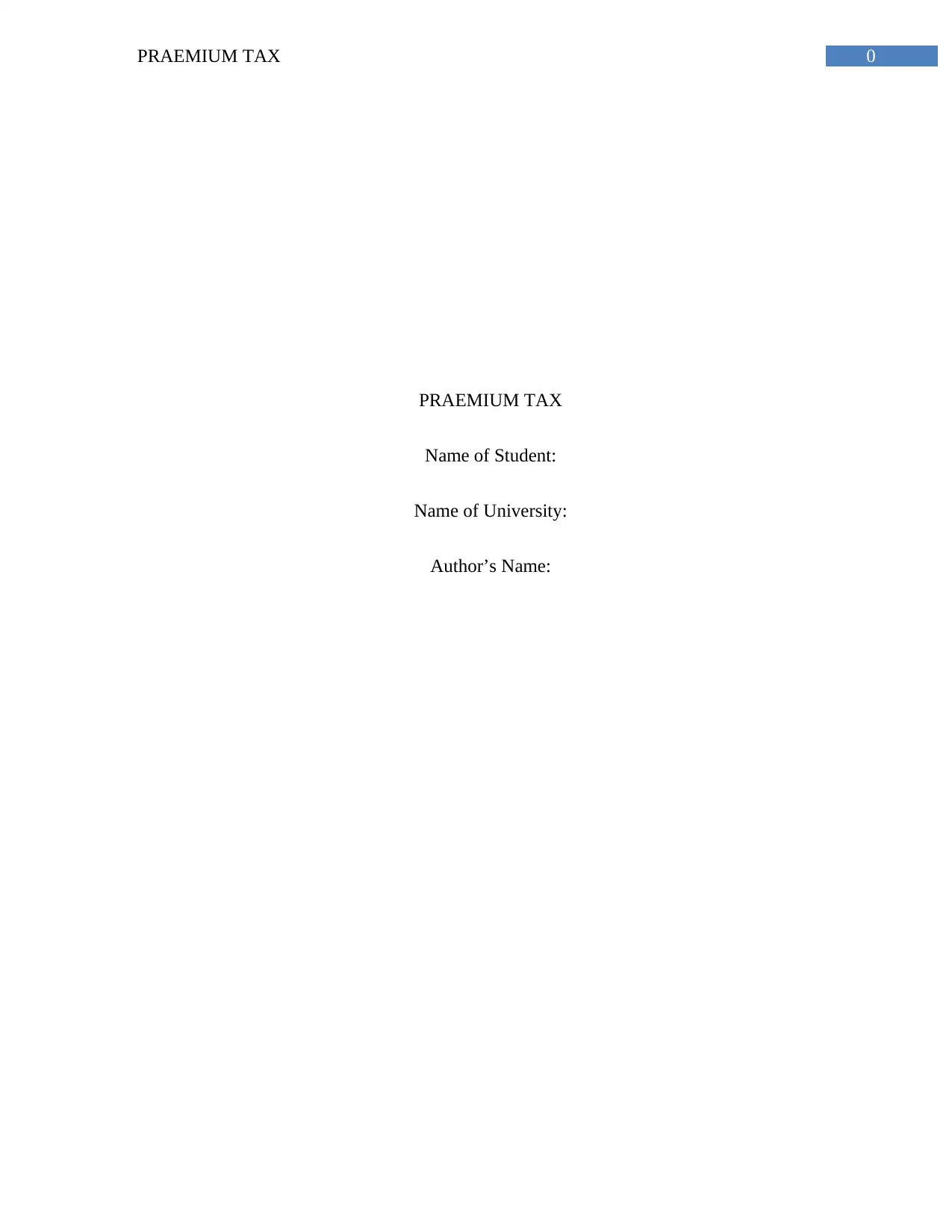
0PRAEMIUM TAX
PRAEMIUM TAX
Name of Student:
Name of University:
Author’s Name:
PRAEMIUM TAX
Name of Student:
Name of University:
Author’s Name:
Paraphrase This Document
Need a fresh take? Get an instant paraphrase of this document with our AI Paraphraser
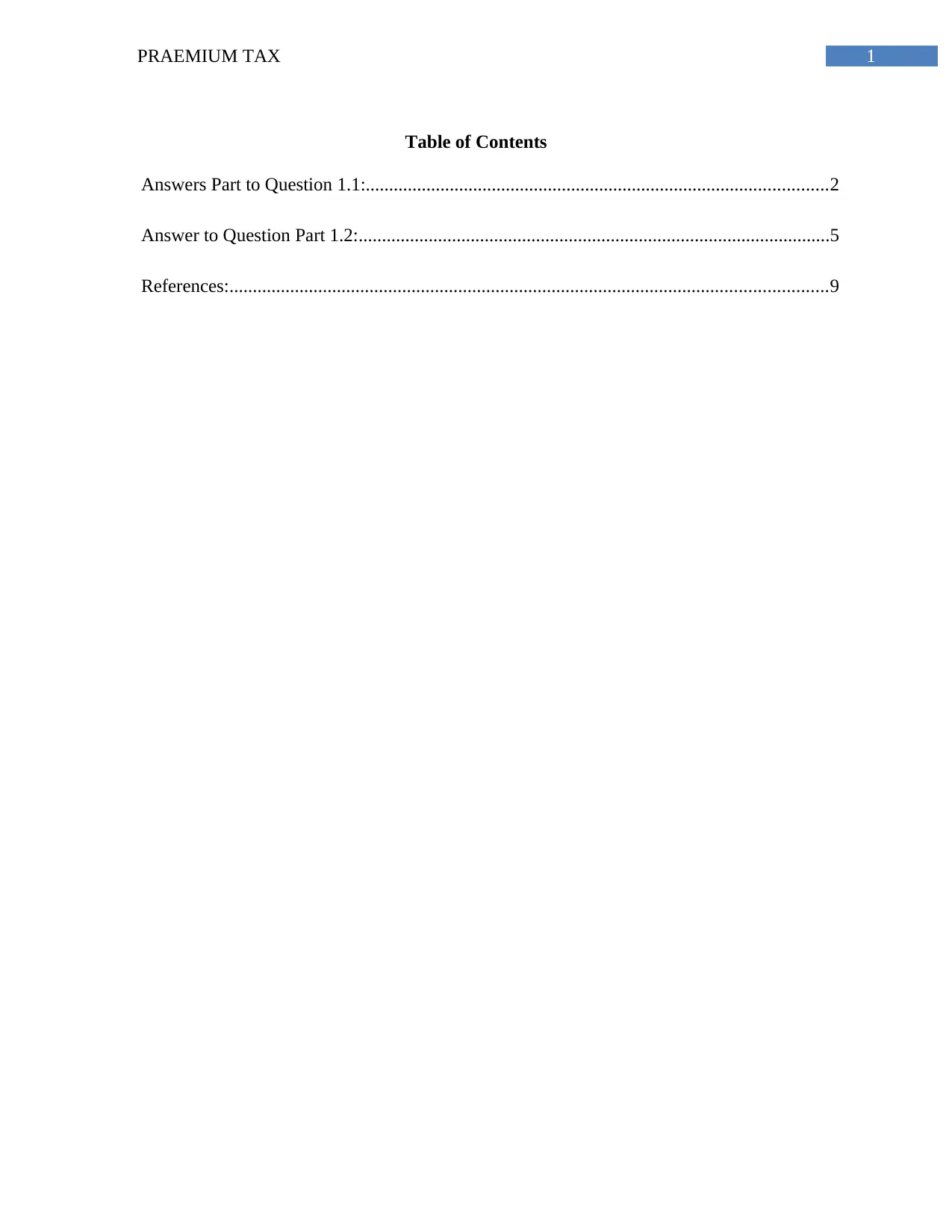
1PRAEMIUM TAX
Table of Contents
Answers Part to Question 1.1:...................................................................................................2
Answer to Question Part 1.2:.....................................................................................................5
References:................................................................................................................................9
Table of Contents
Answers Part to Question 1.1:...................................................................................................2
Answer to Question Part 1.2:.....................................................................................................5
References:................................................................................................................................9
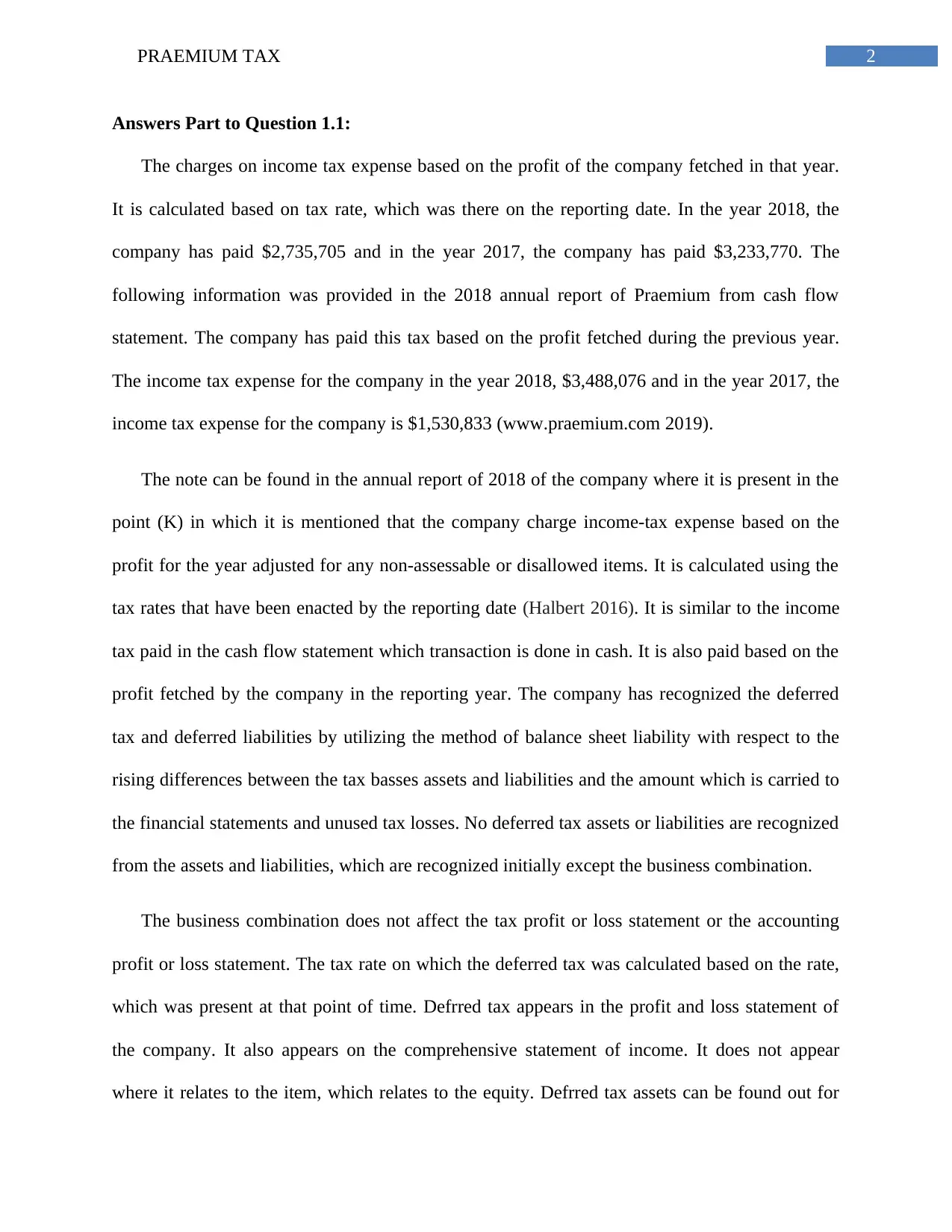
2PRAEMIUM TAX
Answers Part to Question 1.1:
The charges on income tax expense based on the profit of the company fetched in that year.
It is calculated based on tax rate, which was there on the reporting date. In the year 2018, the
company has paid $2,735,705 and in the year 2017, the company has paid $3,233,770. The
following information was provided in the 2018 annual report of Praemium from cash flow
statement. The company has paid this tax based on the profit fetched during the previous year.
The income tax expense for the company in the year 2018, $3,488,076 and in the year 2017, the
income tax expense for the company is $1,530,833 (www.praemium.com 2019).
The note can be found in the annual report of 2018 of the company where it is present in the
point (K) in which it is mentioned that the company charge income-tax expense based on the
profit for the year adjusted for any non-assessable or disallowed items. It is calculated using the
tax rates that have been enacted by the reporting date (Halbert 2016). It is similar to the income
tax paid in the cash flow statement which transaction is done in cash. It is also paid based on the
profit fetched by the company in the reporting year. The company has recognized the deferred
tax and deferred liabilities by utilizing the method of balance sheet liability with respect to the
rising differences between the tax basses assets and liabilities and the amount which is carried to
the financial statements and unused tax losses. No deferred tax assets or liabilities are recognized
from the assets and liabilities, which are recognized initially except the business combination.
The business combination does not affect the tax profit or loss statement or the accounting
profit or loss statement. The tax rate on which the deferred tax was calculated based on the rate,
which was present at that point of time. Defrred tax appears in the profit and loss statement of
the company. It also appears on the comprehensive statement of income. It does not appear
where it relates to the item, which relates to the equity. Defrred tax assets can be found out for
Answers Part to Question 1.1:
The charges on income tax expense based on the profit of the company fetched in that year.
It is calculated based on tax rate, which was there on the reporting date. In the year 2018, the
company has paid $2,735,705 and in the year 2017, the company has paid $3,233,770. The
following information was provided in the 2018 annual report of Praemium from cash flow
statement. The company has paid this tax based on the profit fetched during the previous year.
The income tax expense for the company in the year 2018, $3,488,076 and in the year 2017, the
income tax expense for the company is $1,530,833 (www.praemium.com 2019).
The note can be found in the annual report of 2018 of the company where it is present in the
point (K) in which it is mentioned that the company charge income-tax expense based on the
profit for the year adjusted for any non-assessable or disallowed items. It is calculated using the
tax rates that have been enacted by the reporting date (Halbert 2016). It is similar to the income
tax paid in the cash flow statement which transaction is done in cash. It is also paid based on the
profit fetched by the company in the reporting year. The company has recognized the deferred
tax and deferred liabilities by utilizing the method of balance sheet liability with respect to the
rising differences between the tax basses assets and liabilities and the amount which is carried to
the financial statements and unused tax losses. No deferred tax assets or liabilities are recognized
from the assets and liabilities, which are recognized initially except the business combination.
The business combination does not affect the tax profit or loss statement or the accounting
profit or loss statement. The tax rate on which the deferred tax was calculated based on the rate,
which was present at that point of time. Defrred tax appears in the profit and loss statement of
the company. It also appears on the comprehensive statement of income. It does not appear
where it relates to the item, which relates to the equity. Defrred tax assets can be found out for
⊘ This is a preview!⊘
Do you want full access?
Subscribe today to unlock all pages.

Trusted by 1+ million students worldwide
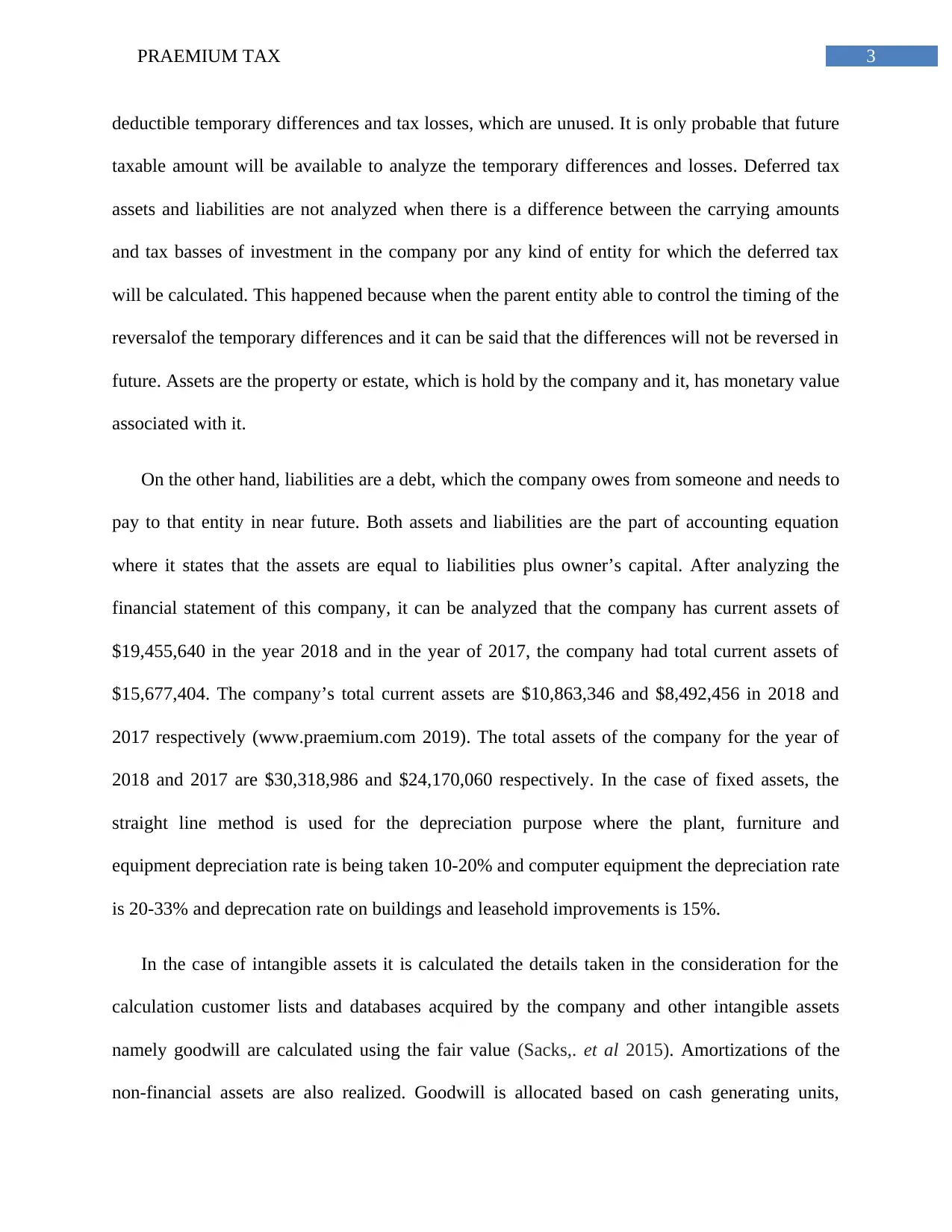
3PRAEMIUM TAX
deductible temporary differences and tax losses, which are unused. It is only probable that future
taxable amount will be available to analyze the temporary differences and losses. Deferred tax
assets and liabilities are not analyzed when there is a difference between the carrying amounts
and tax basses of investment in the company por any kind of entity for which the deferred tax
will be calculated. This happened because when the parent entity able to control the timing of the
reversalof the temporary differences and it can be said that the differences will not be reversed in
future. Assets are the property or estate, which is hold by the company and it, has monetary value
associated with it.
On the other hand, liabilities are a debt, which the company owes from someone and needs to
pay to that entity in near future. Both assets and liabilities are the part of accounting equation
where it states that the assets are equal to liabilities plus owner’s capital. After analyzing the
financial statement of this company, it can be analyzed that the company has current assets of
$19,455,640 in the year 2018 and in the year of 2017, the company had total current assets of
$15,677,404. The company’s total current assets are $10,863,346 and $8,492,456 in 2018 and
2017 respectively (www.praemium.com 2019). The total assets of the company for the year of
2018 and 2017 are $30,318,986 and $24,170,060 respectively. In the case of fixed assets, the
straight line method is used for the depreciation purpose where the plant, furniture and
equipment depreciation rate is being taken 10-20% and computer equipment the depreciation rate
is 20-33% and deprecation rate on buildings and leasehold improvements is 15%.
In the case of intangible assets it is calculated the details taken in the consideration for the
calculation customer lists and databases acquired by the company and other intangible assets
namely goodwill are calculated using the fair value (Sacks,. et al 2015). Amortizations of the
non-financial assets are also realized. Goodwill is allocated based on cash generating units,
deductible temporary differences and tax losses, which are unused. It is only probable that future
taxable amount will be available to analyze the temporary differences and losses. Deferred tax
assets and liabilities are not analyzed when there is a difference between the carrying amounts
and tax basses of investment in the company por any kind of entity for which the deferred tax
will be calculated. This happened because when the parent entity able to control the timing of the
reversalof the temporary differences and it can be said that the differences will not be reversed in
future. Assets are the property or estate, which is hold by the company and it, has monetary value
associated with it.
On the other hand, liabilities are a debt, which the company owes from someone and needs to
pay to that entity in near future. Both assets and liabilities are the part of accounting equation
where it states that the assets are equal to liabilities plus owner’s capital. After analyzing the
financial statement of this company, it can be analyzed that the company has current assets of
$19,455,640 in the year 2018 and in the year of 2017, the company had total current assets of
$15,677,404. The company’s total current assets are $10,863,346 and $8,492,456 in 2018 and
2017 respectively (www.praemium.com 2019). The total assets of the company for the year of
2018 and 2017 are $30,318,986 and $24,170,060 respectively. In the case of fixed assets, the
straight line method is used for the depreciation purpose where the plant, furniture and
equipment depreciation rate is being taken 10-20% and computer equipment the depreciation rate
is 20-33% and deprecation rate on buildings and leasehold improvements is 15%.
In the case of intangible assets it is calculated the details taken in the consideration for the
calculation customer lists and databases acquired by the company and other intangible assets
namely goodwill are calculated using the fair value (Sacks,. et al 2015). Amortizations of the
non-financial assets are also realized. Goodwill is allocated based on cash generating units,
Paraphrase This Document
Need a fresh take? Get an instant paraphrase of this document with our AI Paraphraser
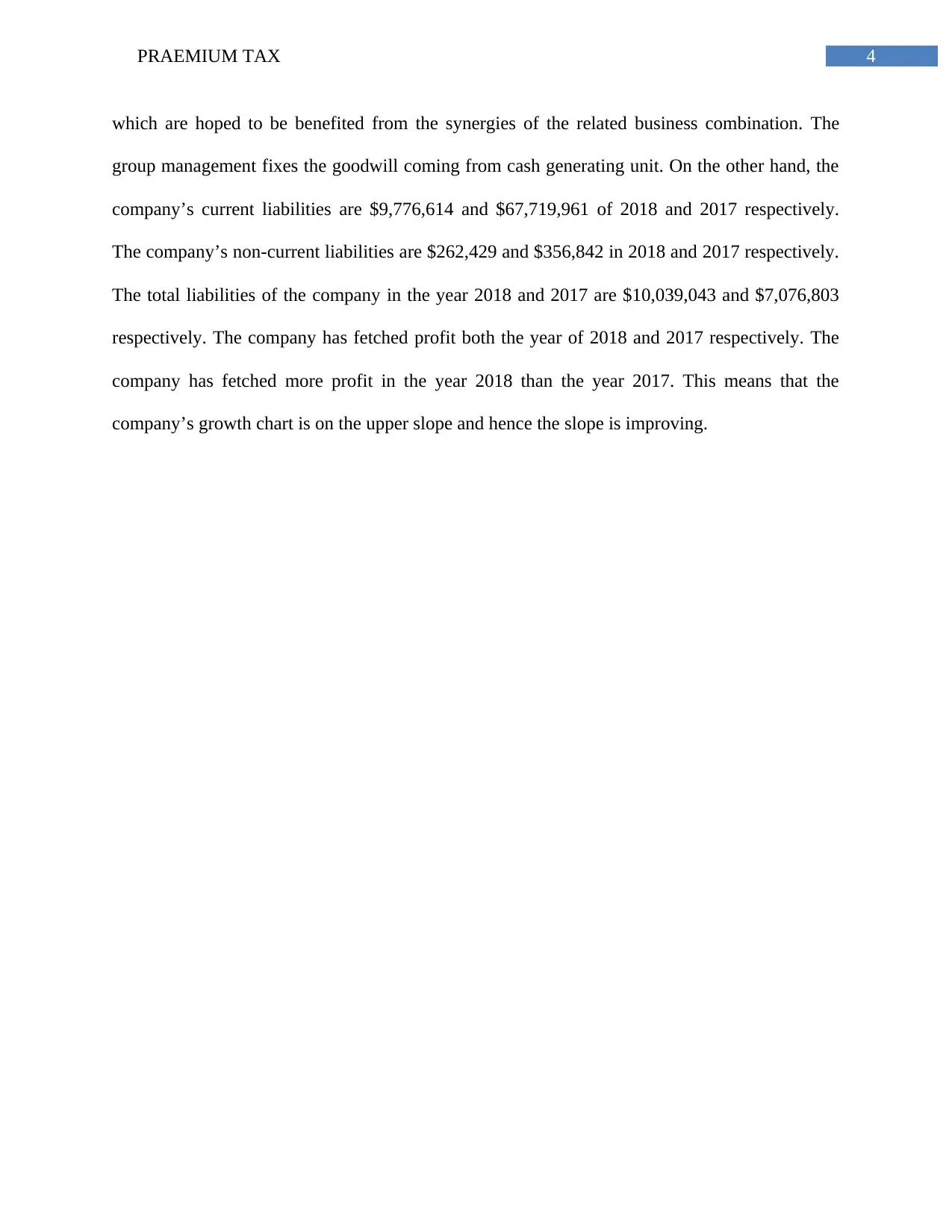
4PRAEMIUM TAX
which are hoped to be benefited from the synergies of the related business combination. The
group management fixes the goodwill coming from cash generating unit. On the other hand, the
company’s current liabilities are $9,776,614 and $67,719,961 of 2018 and 2017 respectively.
The company’s non-current liabilities are $262,429 and $356,842 in 2018 and 2017 respectively.
The total liabilities of the company in the year 2018 and 2017 are $10,039,043 and $7,076,803
respectively. The company has fetched profit both the year of 2018 and 2017 respectively. The
company has fetched more profit in the year 2018 than the year 2017. This means that the
company’s growth chart is on the upper slope and hence the slope is improving.
which are hoped to be benefited from the synergies of the related business combination. The
group management fixes the goodwill coming from cash generating unit. On the other hand, the
company’s current liabilities are $9,776,614 and $67,719,961 of 2018 and 2017 respectively.
The company’s non-current liabilities are $262,429 and $356,842 in 2018 and 2017 respectively.
The total liabilities of the company in the year 2018 and 2017 are $10,039,043 and $7,076,803
respectively. The company has fetched profit both the year of 2018 and 2017 respectively. The
company has fetched more profit in the year 2018 than the year 2017. This means that the
company’s growth chart is on the upper slope and hence the slope is improving.
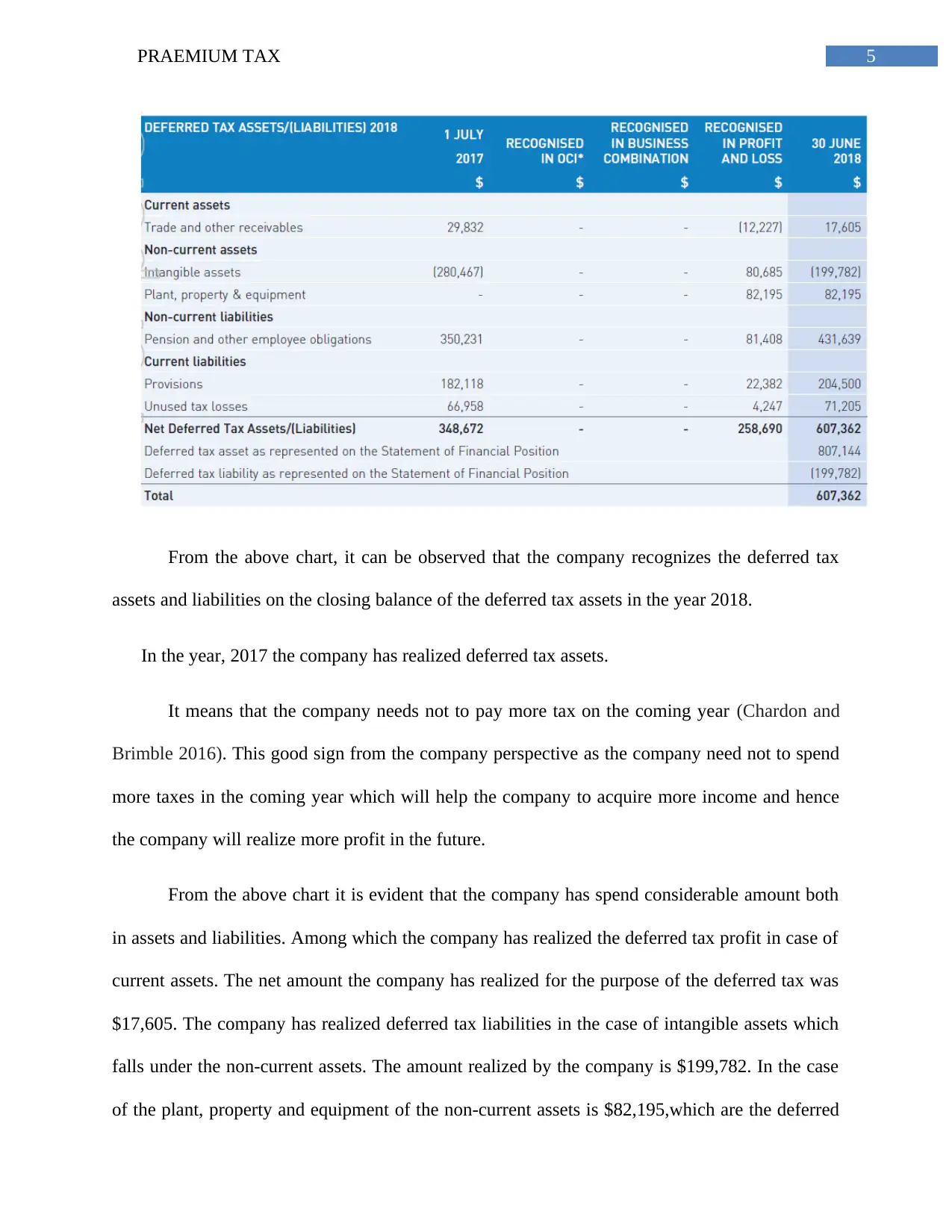
5PRAEMIUM TAX
From the above chart, it can be observed that the company recognizes the deferred tax
assets and liabilities on the closing balance of the deferred tax assets in the year 2018.
In the year, 2017 the company has realized deferred tax assets.
It means that the company needs not to pay more tax on the coming year (Chardon and
Brimble 2016). This good sign from the company perspective as the company need not to spend
more taxes in the coming year which will help the company to acquire more income and hence
the company will realize more profit in the future.
From the above chart it is evident that the company has spend considerable amount both
in assets and liabilities. Among which the company has realized the deferred tax profit in case of
current assets. The net amount the company has realized for the purpose of the deferred tax was
$17,605. The company has realized deferred tax liabilities in the case of intangible assets which
falls under the non-current assets. The amount realized by the company is $199,782. In the case
of the plant, property and equipment of the non-current assets is $82,195,which are the deferred
From the above chart, it can be observed that the company recognizes the deferred tax
assets and liabilities on the closing balance of the deferred tax assets in the year 2018.
In the year, 2017 the company has realized deferred tax assets.
It means that the company needs not to pay more tax on the coming year (Chardon and
Brimble 2016). This good sign from the company perspective as the company need not to spend
more taxes in the coming year which will help the company to acquire more income and hence
the company will realize more profit in the future.
From the above chart it is evident that the company has spend considerable amount both
in assets and liabilities. Among which the company has realized the deferred tax profit in case of
current assets. The net amount the company has realized for the purpose of the deferred tax was
$17,605. The company has realized deferred tax liabilities in the case of intangible assets which
falls under the non-current assets. The amount realized by the company is $199,782. In the case
of the plant, property and equipment of the non-current assets is $82,195,which are the deferred
⊘ This is a preview!⊘
Do you want full access?
Subscribe today to unlock all pages.

Trusted by 1+ million students worldwide
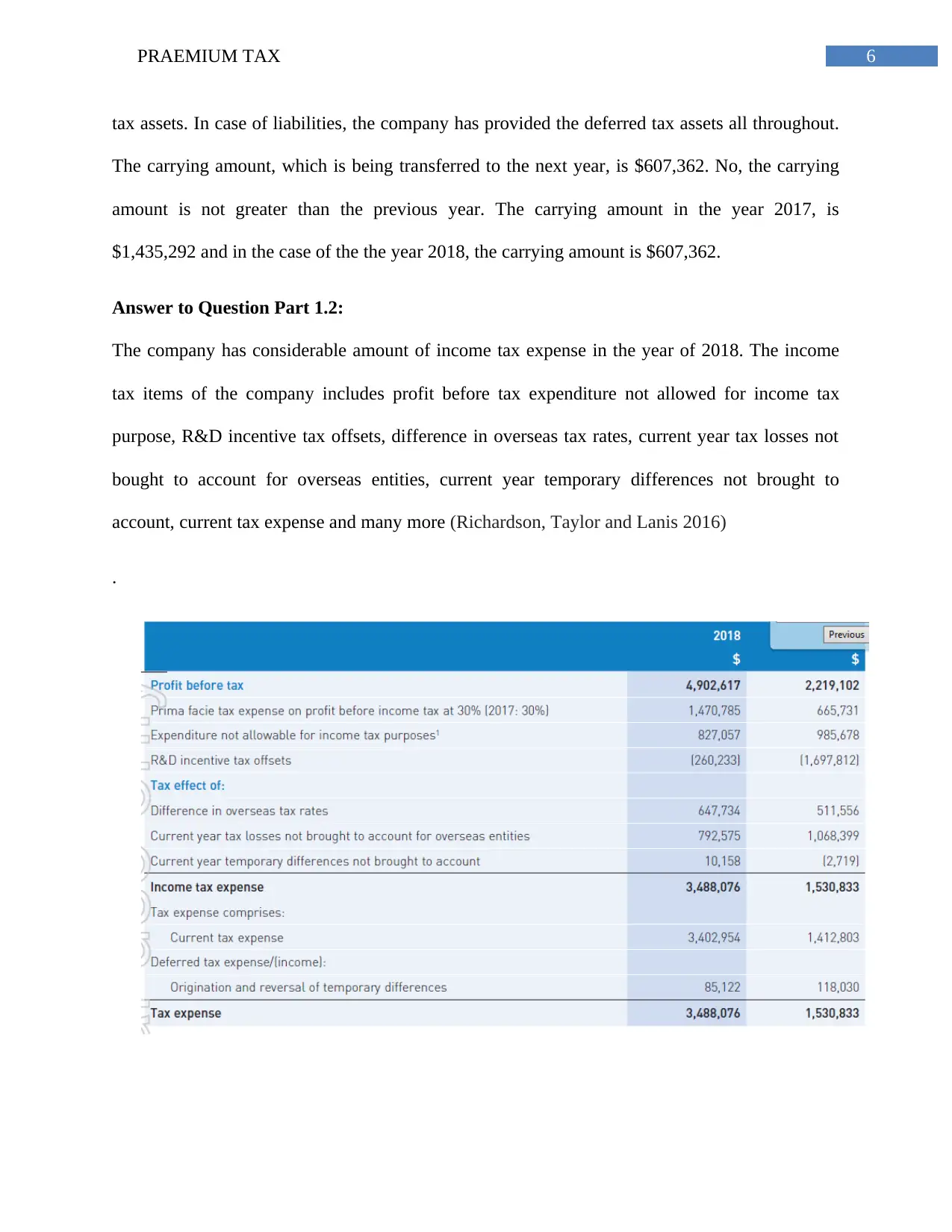
6PRAEMIUM TAX
tax assets. In case of liabilities, the company has provided the deferred tax assets all throughout.
The carrying amount, which is being transferred to the next year, is $607,362. No, the carrying
amount is not greater than the previous year. The carrying amount in the year 2017, is
$1,435,292 and in the case of the the year 2018, the carrying amount is $607,362.
Answer to Question Part 1.2:
The company has considerable amount of income tax expense in the year of 2018. The income
tax items of the company includes profit before tax expenditure not allowed for income tax
purpose, R&D incentive tax offsets, difference in overseas tax rates, current year tax losses not
bought to account for overseas entities, current year temporary differences not brought to
account, current tax expense and many more (Richardson, Taylor and Lanis 2016)
.
tax assets. In case of liabilities, the company has provided the deferred tax assets all throughout.
The carrying amount, which is being transferred to the next year, is $607,362. No, the carrying
amount is not greater than the previous year. The carrying amount in the year 2017, is
$1,435,292 and in the case of the the year 2018, the carrying amount is $607,362.
Answer to Question Part 1.2:
The company has considerable amount of income tax expense in the year of 2018. The income
tax items of the company includes profit before tax expenditure not allowed for income tax
purpose, R&D incentive tax offsets, difference in overseas tax rates, current year tax losses not
bought to account for overseas entities, current year temporary differences not brought to
account, current tax expense and many more (Richardson, Taylor and Lanis 2016)
.
Paraphrase This Document
Need a fresh take? Get an instant paraphrase of this document with our AI Paraphraser
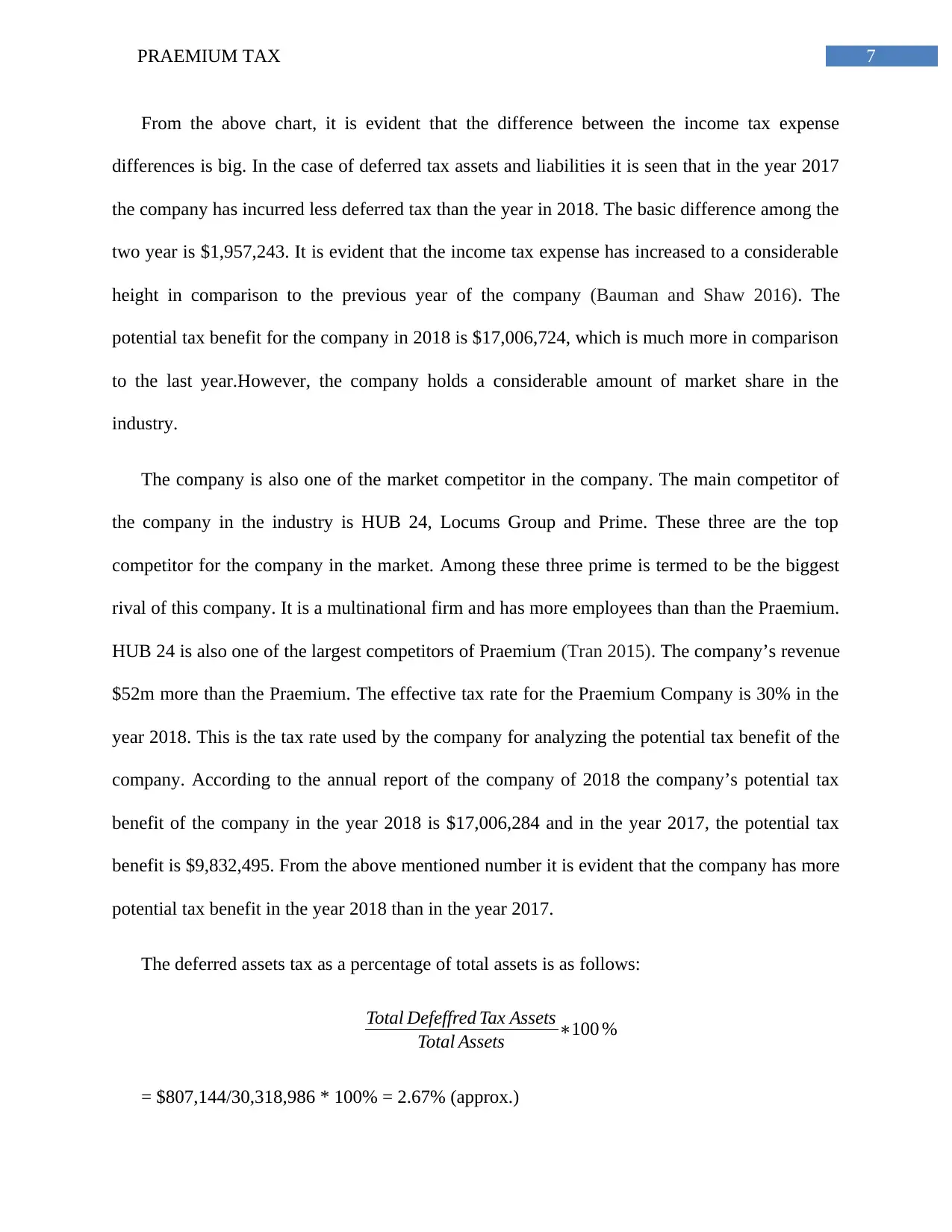
7PRAEMIUM TAX
From the above chart, it is evident that the difference between the income tax expense
differences is big. In the case of deferred tax assets and liabilities it is seen that in the year 2017
the company has incurred less deferred tax than the year in 2018. The basic difference among the
two year is $1,957,243. It is evident that the income tax expense has increased to a considerable
height in comparison to the previous year of the company (Bauman and Shaw 2016). The
potential tax benefit for the company in 2018 is $17,006,724, which is much more in comparison
to the last year.However, the company holds a considerable amount of market share in the
industry.
The company is also one of the market competitor in the company. The main competitor of
the company in the industry is HUB 24, Locums Group and Prime. These three are the top
competitor for the company in the market. Among these three prime is termed to be the biggest
rival of this company. It is a multinational firm and has more employees than than the Praemium.
HUB 24 is also one of the largest competitors of Praemium (Tran 2015). The company’s revenue
$52m more than the Praemium. The effective tax rate for the Praemium Company is 30% in the
year 2018. This is the tax rate used by the company for analyzing the potential tax benefit of the
company. According to the annual report of the company of 2018 the company’s potential tax
benefit of the company in the year 2018 is $17,006,284 and in the year 2017, the potential tax
benefit is $9,832,495. From the above mentioned number it is evident that the company has more
potential tax benefit in the year 2018 than in the year 2017.
The deferred assets tax as a percentage of total assets is as follows:
Total Defeffred Tax Assets
Total Assets ∗100 %
= $807,144/30,318,986 * 100% = 2.67% (approx.)
From the above chart, it is evident that the difference between the income tax expense
differences is big. In the case of deferred tax assets and liabilities it is seen that in the year 2017
the company has incurred less deferred tax than the year in 2018. The basic difference among the
two year is $1,957,243. It is evident that the income tax expense has increased to a considerable
height in comparison to the previous year of the company (Bauman and Shaw 2016). The
potential tax benefit for the company in 2018 is $17,006,724, which is much more in comparison
to the last year.However, the company holds a considerable amount of market share in the
industry.
The company is also one of the market competitor in the company. The main competitor of
the company in the industry is HUB 24, Locums Group and Prime. These three are the top
competitor for the company in the market. Among these three prime is termed to be the biggest
rival of this company. It is a multinational firm and has more employees than than the Praemium.
HUB 24 is also one of the largest competitors of Praemium (Tran 2015). The company’s revenue
$52m more than the Praemium. The effective tax rate for the Praemium Company is 30% in the
year 2018. This is the tax rate used by the company for analyzing the potential tax benefit of the
company. According to the annual report of the company of 2018 the company’s potential tax
benefit of the company in the year 2018 is $17,006,284 and in the year 2017, the potential tax
benefit is $9,832,495. From the above mentioned number it is evident that the company has more
potential tax benefit in the year 2018 than in the year 2017.
The deferred assets tax as a percentage of total assets is as follows:
Total Defeffred Tax Assets
Total Assets ∗100 %
= $807,144/30,318,986 * 100% = 2.67% (approx.)
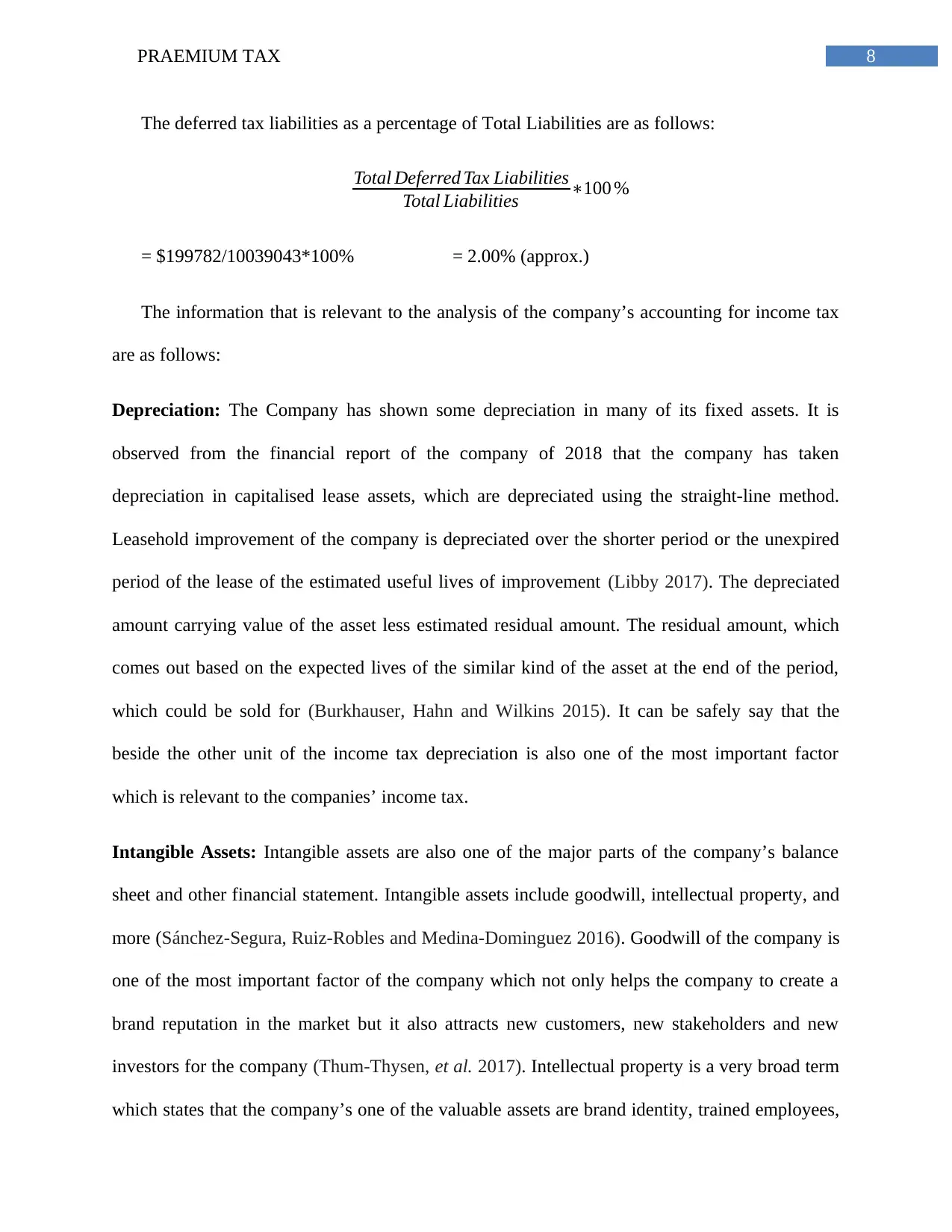
8PRAEMIUM TAX
The deferred tax liabilities as a percentage of Total Liabilities are as follows:
Total Deferred Tax Liabilities
Total Liabilities ∗100 %
= $199782/10039043*100% = 2.00% (approx.)
The information that is relevant to the analysis of the company’s accounting for income tax
are as follows:
Depreciation: The Company has shown some depreciation in many of its fixed assets. It is
observed from the financial report of the company of 2018 that the company has taken
depreciation in capitalised lease assets, which are depreciated using the straight-line method.
Leasehold improvement of the company is depreciated over the shorter period or the unexpired
period of the lease of the estimated useful lives of improvement (Libby 2017). The depreciated
amount carrying value of the asset less estimated residual amount. The residual amount, which
comes out based on the expected lives of the similar kind of the asset at the end of the period,
which could be sold for (Burkhauser, Hahn and Wilkins 2015). It can be safely say that the
beside the other unit of the income tax depreciation is also one of the most important factor
which is relevant to the companies’ income tax.
Intangible Assets: Intangible assets are also one of the major parts of the company’s balance
sheet and other financial statement. Intangible assets include goodwill, intellectual property, and
more (Sánchez-Segura, Ruiz-Robles and Medina-Dominguez 2016). Goodwill of the company is
one of the most important factor of the company which not only helps the company to create a
brand reputation in the market but it also attracts new customers, new stakeholders and new
investors for the company (Thum-Thysen, et al. 2017). Intellectual property is a very broad term
which states that the company’s one of the valuable assets are brand identity, trained employees,
The deferred tax liabilities as a percentage of Total Liabilities are as follows:
Total Deferred Tax Liabilities
Total Liabilities ∗100 %
= $199782/10039043*100% = 2.00% (approx.)
The information that is relevant to the analysis of the company’s accounting for income tax
are as follows:
Depreciation: The Company has shown some depreciation in many of its fixed assets. It is
observed from the financial report of the company of 2018 that the company has taken
depreciation in capitalised lease assets, which are depreciated using the straight-line method.
Leasehold improvement of the company is depreciated over the shorter period or the unexpired
period of the lease of the estimated useful lives of improvement (Libby 2017). The depreciated
amount carrying value of the asset less estimated residual amount. The residual amount, which
comes out based on the expected lives of the similar kind of the asset at the end of the period,
which could be sold for (Burkhauser, Hahn and Wilkins 2015). It can be safely say that the
beside the other unit of the income tax depreciation is also one of the most important factor
which is relevant to the companies’ income tax.
Intangible Assets: Intangible assets are also one of the major parts of the company’s balance
sheet and other financial statement. Intangible assets include goodwill, intellectual property, and
more (Sánchez-Segura, Ruiz-Robles and Medina-Dominguez 2016). Goodwill of the company is
one of the most important factor of the company which not only helps the company to create a
brand reputation in the market but it also attracts new customers, new stakeholders and new
investors for the company (Thum-Thysen, et al. 2017). Intellectual property is a very broad term
which states that the company’s one of the valuable assets are brand identity, trained employees,
⊘ This is a preview!⊘
Do you want full access?
Subscribe today to unlock all pages.

Trusted by 1+ million students worldwide
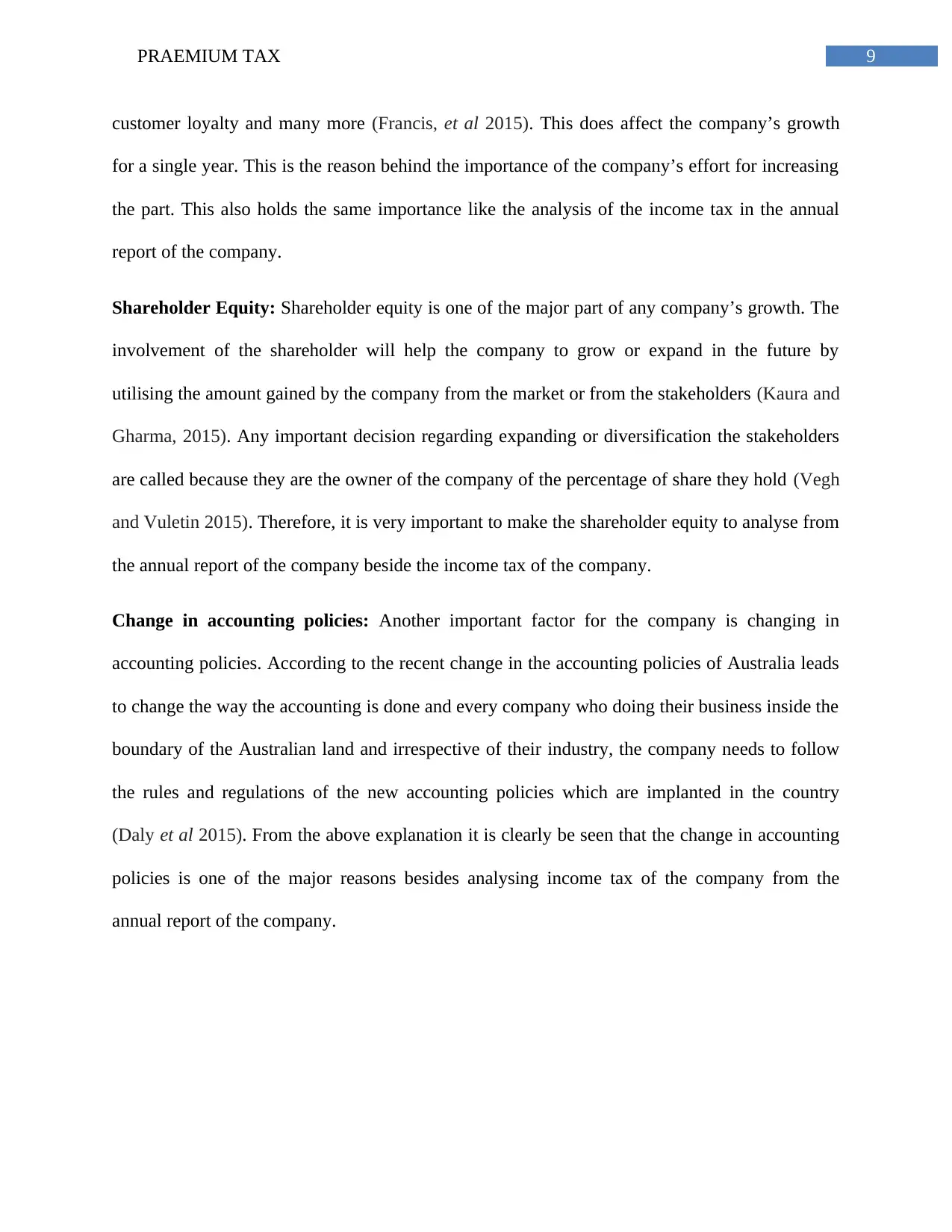
9PRAEMIUM TAX
customer loyalty and many more (Francis, et al 2015). This does affect the company’s growth
for a single year. This is the reason behind the importance of the company’s effort for increasing
the part. This also holds the same importance like the analysis of the income tax in the annual
report of the company.
Shareholder Equity: Shareholder equity is one of the major part of any company’s growth. The
involvement of the shareholder will help the company to grow or expand in the future by
utilising the amount gained by the company from the market or from the stakeholders (Kaura and
Gharma, 2015). Any important decision regarding expanding or diversification the stakeholders
are called because they are the owner of the company of the percentage of share they hold (Vegh
and Vuletin 2015). Therefore, it is very important to make the shareholder equity to analyse from
the annual report of the company beside the income tax of the company.
Change in accounting policies: Another important factor for the company is changing in
accounting policies. According to the recent change in the accounting policies of Australia leads
to change the way the accounting is done and every company who doing their business inside the
boundary of the Australian land and irrespective of their industry, the company needs to follow
the rules and regulations of the new accounting policies which are implanted in the country
(Daly et al 2015). From the above explanation it is clearly be seen that the change in accounting
policies is one of the major reasons besides analysing income tax of the company from the
annual report of the company.
customer loyalty and many more (Francis, et al 2015). This does affect the company’s growth
for a single year. This is the reason behind the importance of the company’s effort for increasing
the part. This also holds the same importance like the analysis of the income tax in the annual
report of the company.
Shareholder Equity: Shareholder equity is one of the major part of any company’s growth. The
involvement of the shareholder will help the company to grow or expand in the future by
utilising the amount gained by the company from the market or from the stakeholders (Kaura and
Gharma, 2015). Any important decision regarding expanding or diversification the stakeholders
are called because they are the owner of the company of the percentage of share they hold (Vegh
and Vuletin 2015). Therefore, it is very important to make the shareholder equity to analyse from
the annual report of the company beside the income tax of the company.
Change in accounting policies: Another important factor for the company is changing in
accounting policies. According to the recent change in the accounting policies of Australia leads
to change the way the accounting is done and every company who doing their business inside the
boundary of the Australian land and irrespective of their industry, the company needs to follow
the rules and regulations of the new accounting policies which are implanted in the country
(Daly et al 2015). From the above explanation it is clearly be seen that the change in accounting
policies is one of the major reasons besides analysing income tax of the company from the
annual report of the company.
Paraphrase This Document
Need a fresh take? Get an instant paraphrase of this document with our AI Paraphraser
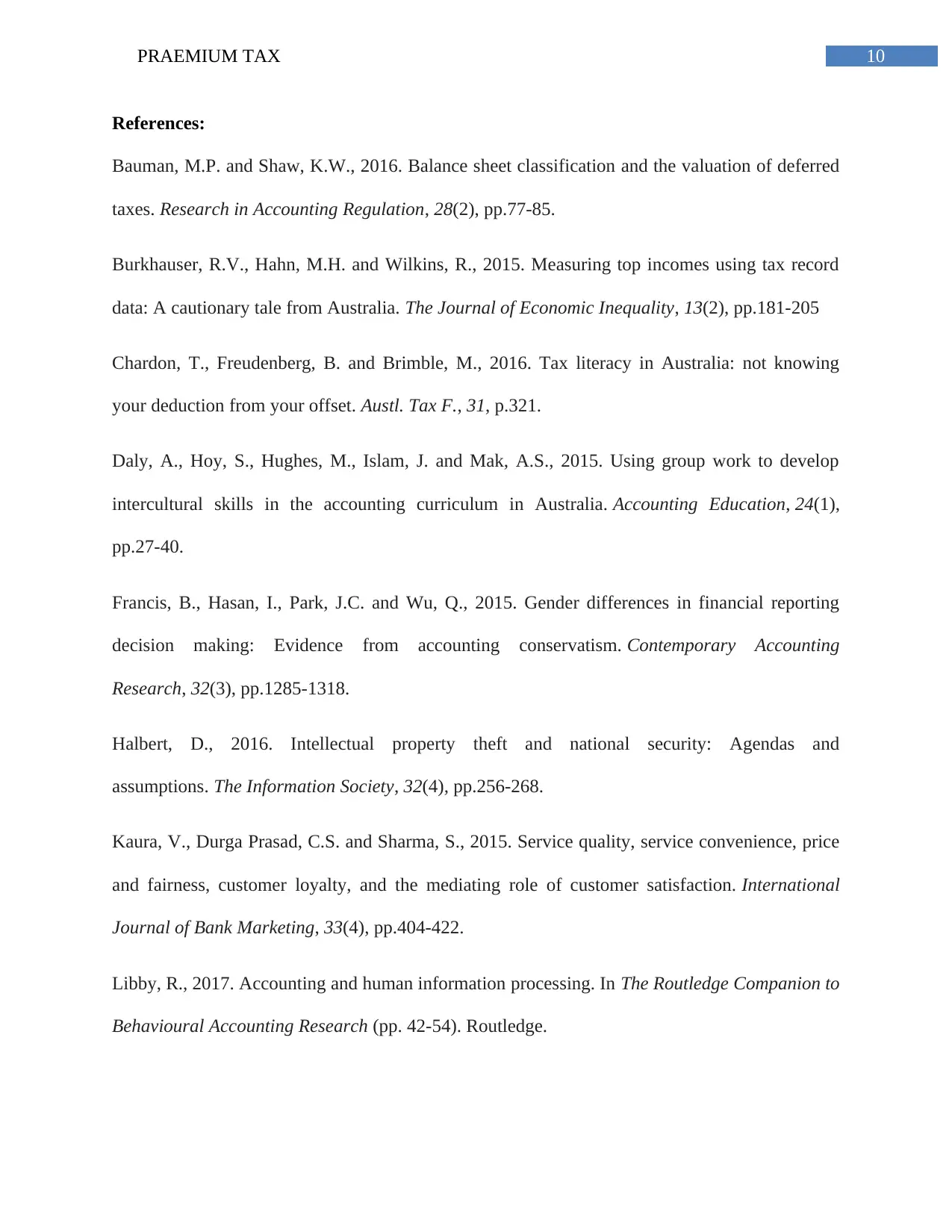
10PRAEMIUM TAX
References:
Bauman, M.P. and Shaw, K.W., 2016. Balance sheet classification and the valuation of deferred
taxes. Research in Accounting Regulation, 28(2), pp.77-85.
Burkhauser, R.V., Hahn, M.H. and Wilkins, R., 2015. Measuring top incomes using tax record
data: A cautionary tale from Australia. The Journal of Economic Inequality, 13(2), pp.181-205
Chardon, T., Freudenberg, B. and Brimble, M., 2016. Tax literacy in Australia: not knowing
your deduction from your offset. Austl. Tax F., 31, p.321.
Daly, A., Hoy, S., Hughes, M., Islam, J. and Mak, A.S., 2015. Using group work to develop
intercultural skills in the accounting curriculum in Australia. Accounting Education, 24(1),
pp.27-40.
Francis, B., Hasan, I., Park, J.C. and Wu, Q., 2015. Gender differences in financial reporting
decision making: Evidence from accounting conservatism. Contemporary Accounting
Research, 32(3), pp.1285-1318.
Halbert, D., 2016. Intellectual property theft and national security: Agendas and
assumptions. The Information Society, 32(4), pp.256-268.
Kaura, V., Durga Prasad, C.S. and Sharma, S., 2015. Service quality, service convenience, price
and fairness, customer loyalty, and the mediating role of customer satisfaction. International
Journal of Bank Marketing, 33(4), pp.404-422.
Libby, R., 2017. Accounting and human information processing. In The Routledge Companion to
Behavioural Accounting Research (pp. 42-54). Routledge.
References:
Bauman, M.P. and Shaw, K.W., 2016. Balance sheet classification and the valuation of deferred
taxes. Research in Accounting Regulation, 28(2), pp.77-85.
Burkhauser, R.V., Hahn, M.H. and Wilkins, R., 2015. Measuring top incomes using tax record
data: A cautionary tale from Australia. The Journal of Economic Inequality, 13(2), pp.181-205
Chardon, T., Freudenberg, B. and Brimble, M., 2016. Tax literacy in Australia: not knowing
your deduction from your offset. Austl. Tax F., 31, p.321.
Daly, A., Hoy, S., Hughes, M., Islam, J. and Mak, A.S., 2015. Using group work to develop
intercultural skills in the accounting curriculum in Australia. Accounting Education, 24(1),
pp.27-40.
Francis, B., Hasan, I., Park, J.C. and Wu, Q., 2015. Gender differences in financial reporting
decision making: Evidence from accounting conservatism. Contemporary Accounting
Research, 32(3), pp.1285-1318.
Halbert, D., 2016. Intellectual property theft and national security: Agendas and
assumptions. The Information Society, 32(4), pp.256-268.
Kaura, V., Durga Prasad, C.S. and Sharma, S., 2015. Service quality, service convenience, price
and fairness, customer loyalty, and the mediating role of customer satisfaction. International
Journal of Bank Marketing, 33(4), pp.404-422.
Libby, R., 2017. Accounting and human information processing. In The Routledge Companion to
Behavioural Accounting Research (pp. 42-54). Routledge.
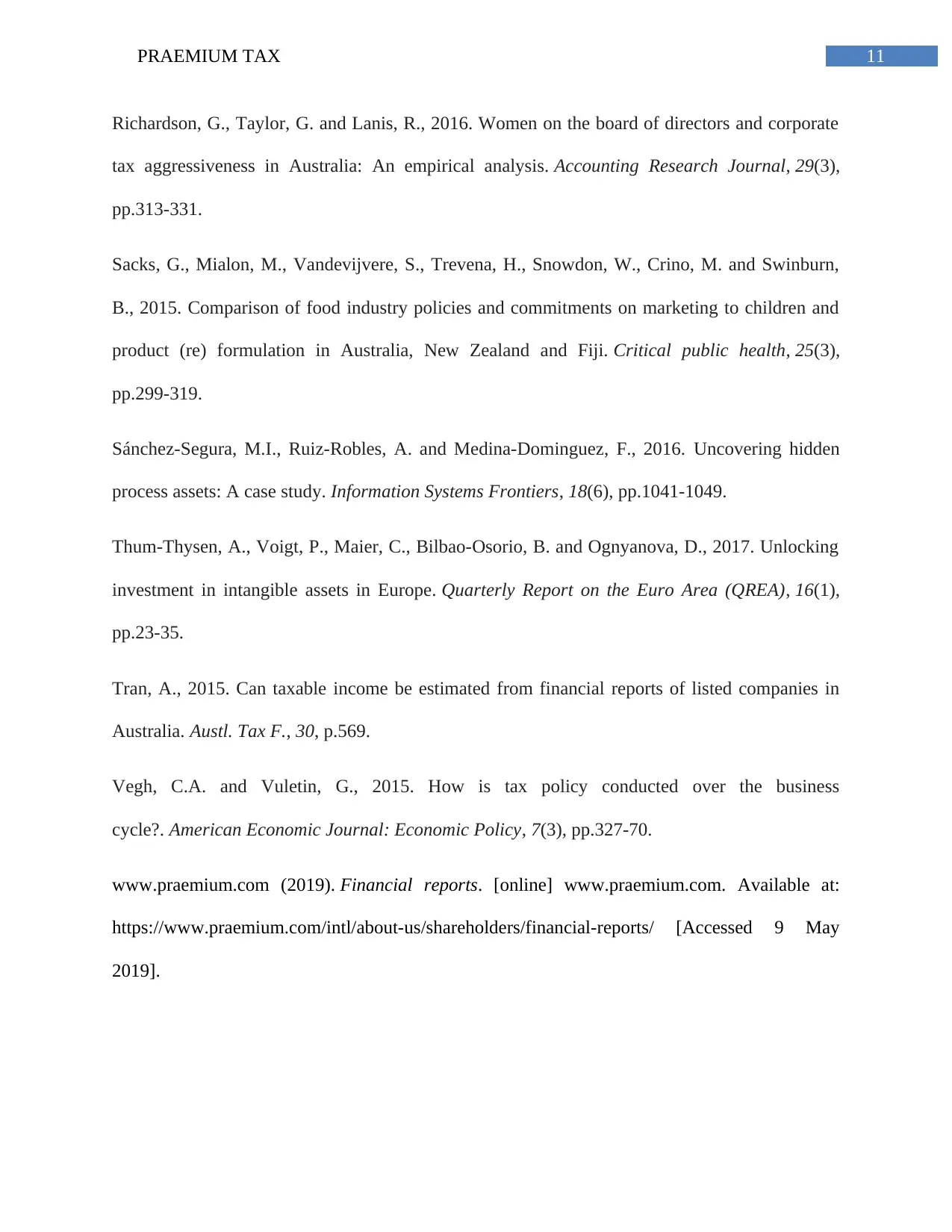
11PRAEMIUM TAX
Richardson, G., Taylor, G. and Lanis, R., 2016. Women on the board of directors and corporate
tax aggressiveness in Australia: An empirical analysis. Accounting Research Journal, 29(3),
pp.313-331.
Sacks, G., Mialon, M., Vandevijvere, S., Trevena, H., Snowdon, W., Crino, M. and Swinburn,
B., 2015. Comparison of food industry policies and commitments on marketing to children and
product (re) formulation in Australia, New Zealand and Fiji. Critical public health, 25(3),
pp.299-319.
Sánchez-Segura, M.I., Ruiz-Robles, A. and Medina-Dominguez, F., 2016. Uncovering hidden
process assets: A case study. Information Systems Frontiers, 18(6), pp.1041-1049.
Thum-Thysen, A., Voigt, P., Maier, C., Bilbao-Osorio, B. and Ognyanova, D., 2017. Unlocking
investment in intangible assets in Europe. Quarterly Report on the Euro Area (QREA), 16(1),
pp.23-35.
Tran, A., 2015. Can taxable income be estimated from financial reports of listed companies in
Australia. Austl. Tax F., 30, p.569.
Vegh, C.A. and Vuletin, G., 2015. How is tax policy conducted over the business
cycle?. American Economic Journal: Economic Policy, 7(3), pp.327-70.
www.praemium.com (2019). Financial reports. [online] www.praemium.com. Available at:
https://www.praemium.com/intl/about-us/shareholders/financial-reports/ [Accessed 9 May
2019].
Richardson, G., Taylor, G. and Lanis, R., 2016. Women on the board of directors and corporate
tax aggressiveness in Australia: An empirical analysis. Accounting Research Journal, 29(3),
pp.313-331.
Sacks, G., Mialon, M., Vandevijvere, S., Trevena, H., Snowdon, W., Crino, M. and Swinburn,
B., 2015. Comparison of food industry policies and commitments on marketing to children and
product (re) formulation in Australia, New Zealand and Fiji. Critical public health, 25(3),
pp.299-319.
Sánchez-Segura, M.I., Ruiz-Robles, A. and Medina-Dominguez, F., 2016. Uncovering hidden
process assets: A case study. Information Systems Frontiers, 18(6), pp.1041-1049.
Thum-Thysen, A., Voigt, P., Maier, C., Bilbao-Osorio, B. and Ognyanova, D., 2017. Unlocking
investment in intangible assets in Europe. Quarterly Report on the Euro Area (QREA), 16(1),
pp.23-35.
Tran, A., 2015. Can taxable income be estimated from financial reports of listed companies in
Australia. Austl. Tax F., 30, p.569.
Vegh, C.A. and Vuletin, G., 2015. How is tax policy conducted over the business
cycle?. American Economic Journal: Economic Policy, 7(3), pp.327-70.
www.praemium.com (2019). Financial reports. [online] www.praemium.com. Available at:
https://www.praemium.com/intl/about-us/shareholders/financial-reports/ [Accessed 9 May
2019].
⊘ This is a preview!⊘
Do you want full access?
Subscribe today to unlock all pages.

Trusted by 1+ million students worldwide
1 out of 12
Related Documents
Your All-in-One AI-Powered Toolkit for Academic Success.
+13062052269
info@desklib.com
Available 24*7 on WhatsApp / Email
![[object Object]](/_next/static/media/star-bottom.7253800d.svg)
Unlock your academic potential
Copyright © 2020–2025 A2Z Services. All Rights Reserved. Developed and managed by ZUCOL.





